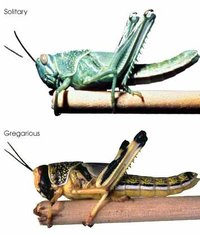Locust
|
|
- For other meanings of the word Locust, see Locust (disambiguation).
- For the biological nomenclature, see Grasshopper.
Locust is the name given to the swarming phase of short-horned grasshoppers of the family Acrididae. Locusts are grasshoppers that are capable of swarming (see below) under certain conditions. The origins and apparent extinction of certain species of locust—some of which reach 6 inches (15 cm) in length—are unclear.
These species can breed rapidly under suitable conditions and subsequently become gregarious and migratory. They form bands as nymphs and swarms as adults both of which travel great distances during which they can strip fields rapidly and in so doing greatly damage crop yields. An exacerbating factor in the damage to crops caused by locusts is their ability to adapt to eating almost any food plant.
Some examples of Locust species are: the Migratory locust (Locusta migratoria), Red locust (Nomadracis septemfasciata), Australian plague locust (Chortoicetes terminifera), and the Desert locust (Schistocerca gregaria). The latter is probably the most important in terms of its very wide distribution (North Africa, Middle East, and Indian subcontinent) and its ability to migrate very widely. The Rocky Mountain locust (Melanoplus spretus) in North America had some of the largest recorded swarms, but died out in the late 19th century.
Locusts in history and literature
According to the Bible, a swarm of locusts comprised the eighth plague in the story of the plagues of Egypt.
In Plato's Phaedrus Socrates says that locusts were once human. When the Muses first brought song into the world, the beauty so captivated some people that they forgot to eat and drink until they died. The Muses turned those unfortunate souls into locusts--singing their entire lives.
In the novel On the Banks of Plum Creek in the Little House on the Prairie book series, a plague of locusts drive Laura Ingalls and her family away from their home in Missouri (though in reality it may have been Minnesota where the incident occurred)[1] (http://ag.smsu.edu/hopper1.htm).
External Links
More detailed information on locusts can be found at the pages of the Australian Plague Locust Commission (http://www.affa.gov.au/content/output.cfm?ObjectID=6C7252C0-ED16-4E8C-823F1CA051DC23E5&contType=outputs).de:Heuschrecke es:Langosta (insecto) eo:Akrido fr:Locuste he:ארבה ja:イナゴ nl:Treksprinkhaan sw:Nzige

